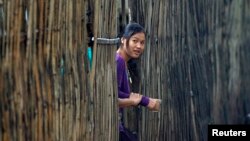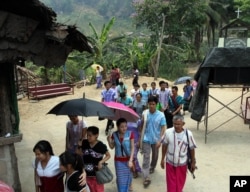Tens of thousands of Burmese refugees living in Thailand are more optimistic about returning following the November 8 election wins of the National League for Democracy (NLD) led by Aung San Suu Kyi. However, many who fled decades of conflict in Myanmar remain cautious.
Myanmar has faced years of internal conflict as myriad ethnic armies waged war against the military-led government in a bid for autonomy, sending more than 120,000 refugees fleeing.
Many live in several official camps along Thailand’s western border and have seen little chance for returning home.
But the November 8 election of the NLD has changed that outlook. Many in the camps have long supported Suu Kyi and deeply opposed the military government.
Sally Thompson, who has worked in programs assisting the refugees for over 20 years and is now director of the non-government Burma Border Consortium, said the election result foreshadows a time when the refugee camps eventually will be closed.
“There’s certainly – I think we have to say – there is definitely an understanding now the camps will not be there indefinitely. That the situation inside the country is changing and return is likely in the near future. Yes it is a possibility but exactly when that will be – there is no one right time. There will be different times for different communities,” said Thompson.
But Thompson added that many refugees remain hesitant, their concerns lying with security and safety in regions long engulfed by conflict.
“They’re still very much looking to see whether there will be security. They are thinking about their own protection, their families, the issues of land and livelihood. There are many issues that need to be resolved before people are really ready to return,” she said.
Recent ceasefire agreements between President Thein Sein and eight armed ethnic groups added to the positive climate. But the October agreement fell short of being a nationwide agreement, with seven of the 15 armed groups declining to sign on amid mistrust with the government and the military.
Since the election, several groups who refused to sign say they are more willing to participate in future talks with the NLD led government. But some analysts remain pessimistic over conflict ending in key regions, as the new government, due to take power, must still deal with Myanmar’s powerful army.
Vivian Tan, regional spokesperson for the United Nations High Commission for Refugees (UNHCR), said the ceasefire agreements will be key in the refugees’ decision making of returning to Burma.
“The national ceasefire agreement is just as important – if not more important for the refugees because they really want to see the provisions of this agreement upheld – that there is a firm end to the conflict so they can resume their lives back home,” said Tan.
The UNHCR’s position, said Tan, is for the refugees to return voluntarily backed by continuing support from international donors.
More than 100,000 Burmese refugees living in Thailand since 2005 have been resettled in third countries – some 75,000 being settled in the United States alone.








